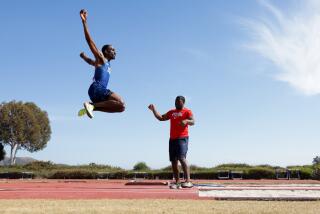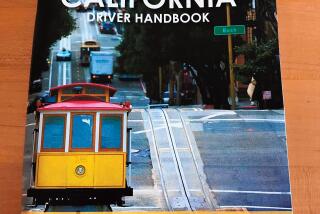Tiny Telescopic Device Puts Legally Blind Drivers on Road in Indiana
INDIANAPOLIS — “I’m going to get a motor car. I’m going to learn how to drive,” said Bruce Quinn, who is 32 and legally blind.
Quinn, who by next summer expects to be running two radio stations 50 miles apart in northern Indiana, may be licensed to drive for the first time, thanks to eyeglasses equipped with small telescopes for making out details such as road signs and stoplights.
“I’m excited about it. I got a moped a few years ago, and I’ve had a lot of fun with it and never any trouble, so I should be all right,” Quinn, of Delphi, said. “It offers me a lot of opportunities--something called freedom. Goodby to Greyhound. A lot of handicapped people are stuck on Greyhound.”
California and Texas have been licensing bioptic drivers for more than 10 years, and about 25 states have such programs for as many as 2,000 drivers nationwide, said Warren Brown, Indiana Bureau of Motor Vehicles director of licensing.
Brown developed Indiana’s bioptic registration program at the urging of a vocational rehabilitation counselor and with help from low-vision optometrists.
Enthusiastic State Help
“I thought it was the greatest idea in the world when I heard it. It’s nice to do a little good for someone,” he said. “You wouldn’t believe how sad it is to tell a man he cannot drive again. I’ve had men cry. Driving is probably the single most important thing in any man’s life.”
Optometrist Paul Bither, who helped write Indiana’s licensing guidelines, said not everyone fits the program. Getting a license to drive is “a major step toward independence,” but “it’s not something that I push,” he said. “Driving is a great privilege, but it’s also a great responsibility.”
In Indiana, drivers must have vision correctable to 20-200 with glasses and to 20-40 through telescopes with up to 4X magnification, a horizontal visual field of 130 degrees and no major blind spots, color-perception defects or other visual problems. They must be evaluated and fitted for the telescopes, get a six-month learner’s permit and pass special state-sponsored training as well as the usual road test.
The telescopes cost from $500 to more than $2,000. They vary in size and weight, but the most commonly used ones are about one inch in diameter and weigh about 6 ounces. They may extend a few inches at a slight angle upward from the top of the glasses over the user’s strongest eye, in some cases both eyes. When the driver needs to see something he tilts his head forward to peer through the scope.
Driving Range Limited
“Most bioptic drivers, especially the older ones, tend to drive only in familiar areas,” optometrist Dr. Debra McConnaha of Indiana University said. “It’s possible they might be able to drive to the grocery and back without using the telescope. It’s there if they need it.”
Supporters of the program say a bioptic driver must be able to glance through the telescope and spot something in less than a second--about as quickly as a normal driver might glance into the rear-view mirror--but critics say this is impossible.
Dr. Gerald Fonda, a Livingston, N. J., ophthalmologist who’s been prescribing bioptic glasses since 1947, said bioptic drivers need at least three seconds to adjust their focus to the telescope, spot the detail and then readjust to looking through their glasses. He said the telescope creates a blind spot that is twice as wide as the field of vision through it.
“The purpose of the telescope is to pass the driver’s test. There’s no evidence this device is safe, and there is overwhelming evidence it is a hazard,” Fonda said.
Dr. Arthur H. Keeney, professor of ophthalmology at the University of Louisville Medical School, said the telescope makes objects appear to be closer than they are and that its “awning effect” obscures overhead signs. He and Fonda say that poor-vision people should be allowed to drive, but under restrictive conditions such as under 35 m.p.h. only and never on freeways.
Telescopes Criticized
“There are lots of ways to help people without encumbering them with an optical device that imposes limitations,” Keeney said.
Bill Gengler of the California Department of Motor Vehicles said that a 1983 study of the state’s bioptic drivers found that they were nearly twice as likely to have accidents as others.
“The accident rate was higher, but not significantly. In fact, it was lower than rates for a variety of other types of California licensed drivers with different medical conditions,” Gengler said.
Advocates for bioptic drivers say they are among the most careful people on the road. Bioptics say they know their limitations and won’t exceed them.
“We stress the safe-driving aspect as part of the privileges we get as drivers,” said Marc Sessions, president of the 1,000-member American Bioptic Certified Drivers, based in Laguna Niguel, Calif. (He said the group’s initials, ABCD, also stand for Always Be Careful Driving.)
Teresa Canada, 34, of Jasonville, started driving at 16 but lost her license eight years ago because of poor eyesight. “I have to be more careful than others. If I feel I am not capable, I am not going to be on the roads,” said Canada, driving through downtown Indianapolis after her road test in October.
Until she got a bioptic license, Canada had to call her husband at work if an emergency came up at home with any of their four children. “It’s been eight years since I’ve been able to drive, so I’ve been in a kind of a prison.”
More to Read
Sign up for Essential California
The most important California stories and recommendations in your inbox every morning.
You may occasionally receive promotional content from the Los Angeles Times.










